varible phasing
varible phasing
In Andy Ross's book he mentions that he tested phasing from 60 degrees to 180 degrees with interesting results at narrower angles the compression became higher and more difficult to start and required higher temperatures even to run. But when it did run "it did so with great power and speed". As the angle increased the engine was easier to start and had less power and speed but would run at lower temperatures. Now is anyone using variable timing?
Re: varible phasing
Hey aero,
Personally I have never attempted this (but have thought about it in principle). It would be fairly easy in theory to make an engine with variable phasing that you could adjust between runs and then analyse the data.
But to go one better, Koichi Hirata has made a platform where the phase angle can be adjusted, in motion, to give a real time analysis of the effects.
Here is some basic info on the results
http://www.bekkoame.ne.jp/~khirata/english/pe_mse03.htm
and here's a couple of pics and related links.
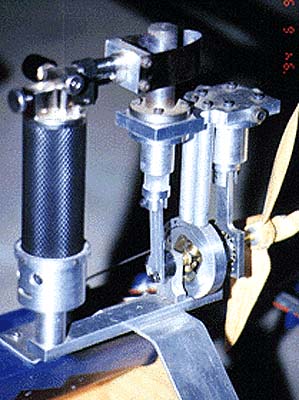
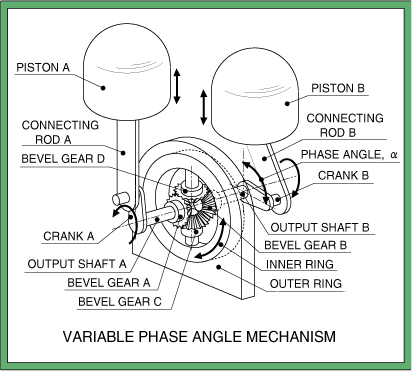
http://www.bekkoame.ne.jp/~khirata/english/pr_mse03.htm
http://www.bekkoame.ne.jp/~khirata/english/mse03e.htm
I know some institutions have attempted research on this, one that comes to mind is the university of Canterbury in New Zealand where a thesis was written on an engine with a displacer that was actuated by an electronically controllable servo instead of the crank mechanism. This would not only allow the phasing angle to be variable, but also allow movement outside of the usual sinusoidal motion of a standard kinematic mechanisms.
The thesis study on this, is available on the uni website if you want to track down the pdf, (i don't have the time at the moment).
Also found this link on another alpha engine
http://pic.sagepub.com/content/221/8/949.abstract
vamoose
Personally I have never attempted this (but have thought about it in principle). It would be fairly easy in theory to make an engine with variable phasing that you could adjust between runs and then analyse the data.
But to go one better, Koichi Hirata has made a platform where the phase angle can be adjusted, in motion, to give a real time analysis of the effects.
Here is some basic info on the results
http://www.bekkoame.ne.jp/~khirata/english/pe_mse03.htm
and here's a couple of pics and related links.


http://www.bekkoame.ne.jp/~khirata/english/pr_mse03.htm
http://www.bekkoame.ne.jp/~khirata/english/mse03e.htm
I know some institutions have attempted research on this, one that comes to mind is the university of Canterbury in New Zealand where a thesis was written on an engine with a displacer that was actuated by an electronically controllable servo instead of the crank mechanism. This would not only allow the phasing angle to be variable, but also allow movement outside of the usual sinusoidal motion of a standard kinematic mechanisms.
The thesis study on this, is available on the uni website if you want to track down the pdf, (i don't have the time at the moment).
Also found this link on another alpha engine
http://pic.sagepub.com/content/221/8/949.abstract
vamoose
Re: varible phasing
Possibly a simpler way to make a variable phase engine, adjustable in motion, might be to build it with the power cylinder mounted on a quadrant so it pivoted around a point concentric with the crankshaft (thinking gamma engine here).
Re: varible phasing
Could also be done the same way with a ALPHA motor of the V type. Or with a G or A motor with parallel cylinders, and adjustable crank position. Ian S C
-
fullofhotair
- Posts: 265
- Joined: Sun Aug 05, 2012 6:28 am
Re: varible phasing
Could either Hopper or Ian SC, elaborate on their ideas? How would you engage the change in phase from outside the engine? Would this be something you could do simply with a tin can model?
Re: varible phasing
The simplest method of adjusting the phase angle is to have one crank adjustable, an example would be a GAMMA motor, with parallel cylinders, say the type with two flywheels, with the crank pins attached to the flywheels. Start with the cranks at 90*, get the motor run, and observe how it runs, and if you are able test the torque, and revs. Mark the position of the crank, the move it forward 5* and test, then same again, and keep going until the motor stops. Now move back to 90*, the rotate the crank back 5* and continue as before. Take notes, and find which position gives the best power. This can be quite time consuming, but very interesting, after the initial testing you may find the best spot is half way between two of the marks, or it might be 90*, or like one of mine, 15* either side of 90* made no difference, it was new then, now that it's run in that could well have changed. Ian S C
-
fullofhotair
- Posts: 265
- Joined: Sun Aug 05, 2012 6:28 am
Re: varible phasing
I was trying to think of a way to change phase as the engine is running. Would changing phase a little help when the engine is under load? Example ,have an easy starting engine at one phase ,then change phase and heat for more power and torque. If the timing is set by attachments on a flywheel I think it would be easier to change phase ,than if you had a crankshaft.
Re: varible phasing
fullofhotair,fullofhotair wrote:I was trying to think of a way to change phase as the engine is running. Would changing phase a little help when the engine is under load? Example ,have an easy starting engine at one phase ,then change phase and heat for more power and torque. If the timing is set by attachments on a flywheel I think it would be easier to change phase ,than if you had a crankshaft.
in a previous post is an example where it can be changed with the engine running :
vamoose wrote: Koichi Hirata has made a platform where the phase angle can be adjusted, in motion, to give a real time analysis of the effects.
Here is some basic info on the results
http://www.bekkoame.ne.jp/~khirata/english/pe_mse03.htm
and here's a couple of pics and related links.

http://www.bekkoame.ne.jp/~khirata/english/pr_mse03.htm
http://www.bekkoame.ne.jp/~khirata/english/mse03e.htm
Re: varible phasing
I was thinking there would also be other ways to vary the phasing relationship, although it would be different to changing the standard "Phase Angle" relationship of true circular rotating engine crank.
-For example, using non-circular gears to change the stroke rate of a kinematic engine to other than a pure-sinusoidal action.
-Or also using a specifically shaped swash-plate design.
Found this video using a swash-plate to demonstrate the concept of an idealised 4 cylinder gamma configuration that is much closer to the ideal carnot cycle than other engines
[youtube]http://www.youtube.com/watch?v=R8ZcdnsUgCc[/youtube]
Eccentric gears could also be used to make movement closer to an idealised carnot cycle for engines of any number of cylinders, instead of the 4 cylinders needed for the swash-plate design.

Elite cyclists use eccentric hubs to optimise the timing of rotational speed with application of the 'Pedal power'
I cant find any engines that have been made using eccentric cogging but did find this patent-
http://www.google.com/patents/US5644917
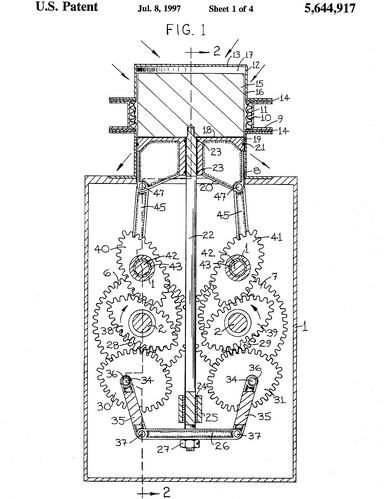
There are some interesting configurations around
Here's a fun site called “507 Mechanical Movements”
The movements that are coloured, are animated if you click on them..
http://507movements.com/index03.html
Google images
http://www.google.com.au/search?q=non+c ... lQWhpYCgCA
Wiki
http://en.wikipedia.org/wiki/Non-circular_gear
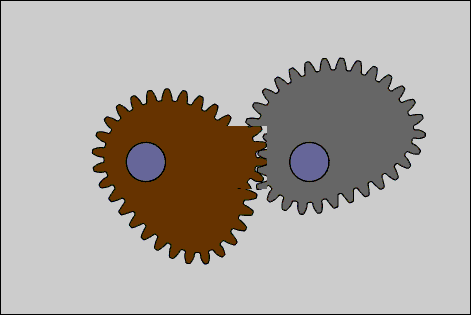

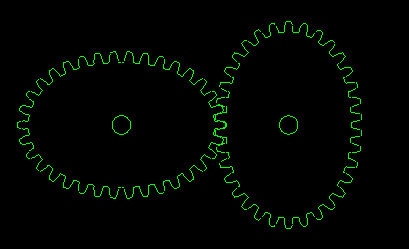
vamoose
-For example, using non-circular gears to change the stroke rate of a kinematic engine to other than a pure-sinusoidal action.
-Or also using a specifically shaped swash-plate design.
Found this video using a swash-plate to demonstrate the concept of an idealised 4 cylinder gamma configuration that is much closer to the ideal carnot cycle than other engines
[youtube]http://www.youtube.com/watch?v=R8ZcdnsUgCc[/youtube]
Eccentric gears could also be used to make movement closer to an idealised carnot cycle for engines of any number of cylinders, instead of the 4 cylinders needed for the swash-plate design.

Elite cyclists use eccentric hubs to optimise the timing of rotational speed with application of the 'Pedal power'
I cant find any engines that have been made using eccentric cogging but did find this patent-
http://www.google.com/patents/US5644917

There are some interesting configurations around
Here's a fun site called “507 Mechanical Movements”
The movements that are coloured, are animated if you click on them..
http://507movements.com/index03.html
Google images
http://www.google.com.au/search?q=non+c ... lQWhpYCgCA
Wiki
http://en.wikipedia.org/wiki/Non-circular_gear



vamoose
Re: varible phasing
Simplest one that can be adjusted while running is a V type GAMMA. Make it as usual with the displacer fixed in place, and the power cylinder able to be rotated either side of the 90* position, I think some thing like this would be a good place to start. Ian S C
-
fullofhotair
- Posts: 265
- Joined: Sun Aug 05, 2012 6:28 am
Re: varible phasing
I just had an idea last night. Think of a clock. It reads 12 15. The hour hand never moves but the minute hand moves from 3 to 4.The clock face is the flywheel. The con rods attach to the ends of the hands. The engine starts out at 90 deg. As the rpms increase a governor, like used on old hit and miss engine, engages and permits centrifugical force to pull the minute hand to 4 Oclock=110 degrees. It shifts gears so to speak.
Re: varible phasing
Maybe mount the power piston con rod to the end of a stepper motor also attached to the main crank. Moved by onboard batteries and controller advanced or retarded by the degrees of the stepper operation. Maybe a bluetooth connection. The stepper would have to have a higher holding torque than the engine could produce.
I like the governor adaptation idea.
RS
I like the governor adaptation idea.
RS
Re: varible phasing
I have to admit to dreams of a small but useful wood-burning tractor with a variable timing system. Besides efficiency benefits, variable timing could be used to throttle an engine or to make a self-starting engine reversible. It could even be used for regenerative braking until something melts. I always thought a simple way to change timing while running would be a long chain or cogged belt with a lot of slack. Idlers would be used to adjust the slack from one side to the other of the drive. Pretty bulky though. The mechanism in that Koichi Hirata engine is basically available in most any auto differential - turning the driveshaft would change the timing between the wheel-shafts. All that said, for small model experiments it seems it would be easier to just stop the engine to change settings.
Bumpkin
Bumpkin
Re: varible phasing
Hey bumpkin did you catch this thread..
http://stirlingengineforum.com/viewtopic.php?f=1&t=1595
It wasn't a complete success but a pretty cool effort.
I think a wood fed Stirling traction type engine is feasible idea (especially with some low gearing), as i have read in another forum about a stationary Stirling engine that was able to run a timber mill, over many years. Apparently they just placed a large log onto a sloped/tilted feed in, and as the log burned it self fed into the firebox.
It would probably be a slow moving beast as a tractor, but could have some serious pull (like the old steam traction engines).
vamoose
http://stirlingengineforum.com/viewtopic.php?f=1&t=1595
It wasn't a complete success but a pretty cool effort.
I think a wood fed Stirling traction type engine is feasible idea (especially with some low gearing), as i have read in another forum about a stationary Stirling engine that was able to run a timber mill, over many years. Apparently they just placed a large log onto a sloped/tilted feed in, and as the log burned it self fed into the firebox.
It would probably be a slow moving beast as a tractor, but could have some serious pull (like the old steam traction engines).
vamoose
-
fullofhotair
- Posts: 265
- Joined: Sun Aug 05, 2012 6:28 am
Re: varible phasing
Maybe variable phasing could be useful on each cycle. What if the displacer movement was more like an isosceles triangle than a circle? The bottom would be flatter ,giving more lag time at the hot end. The sides would be stepper ,giving a faster push pull. The top or would be more pointed. You might need a better cooling system ,but you would get more efficiency from your heat source. These shape changes wouldn't be exaggerated ,but slight.